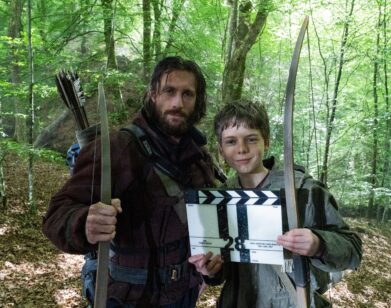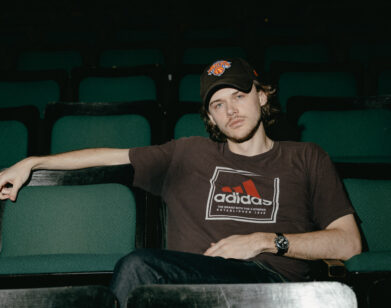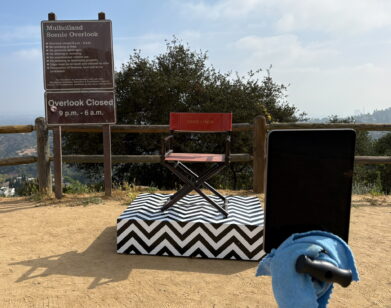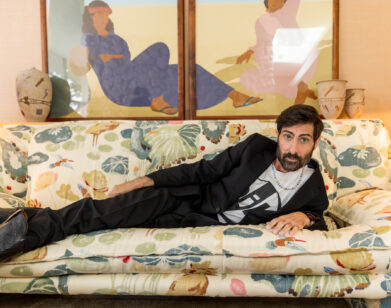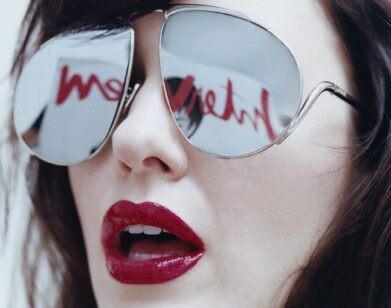Aaron Katz and Martha Stephens on Terra Firma
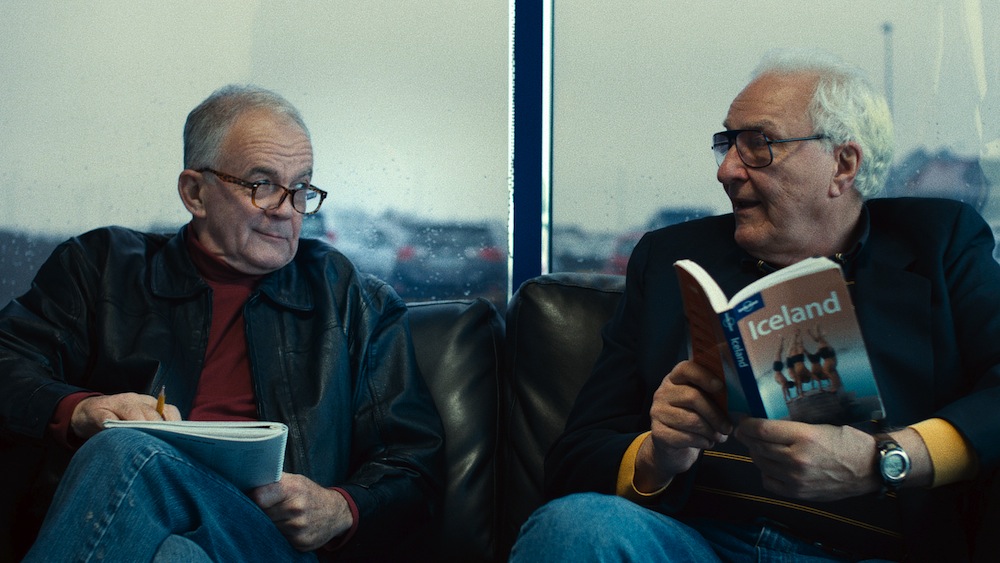
PAUL EENHOORN AS COLIN AND EARL LYNN NELSON AS MITCH IN LAND HO! PHOTO BY ANDREW REED, COURTESY OF SONY PICTURES CLASSICS
In the canon of the middle-aged male buddy comedies, “getting our groove back” seems to be the number-one order of business. Land Ho!, out this Friday, is no exception, as two 60something ex-brothers-in-law, previously married to a pair of sisters, embark on a road trip. But the film, written and directed by Martha Stephens (Pilgrim’s Song, Passenger Pigeons) and Aaron Katz (Cold Weather, Quiet City), supersedes its classic genre and instead establishes itself as a warm-hearted, deeply comedic, and at times, raw and affecting account of friendship, aging, loneliness, and the existential ennui that accompanies it.
The rambunctious and ribald Mitch (Earl Lynn Nelson), always at the ready with a drink, a joint, and a bon mot for good measure, surprises thoughtful and soft-spoken Colin (Paul Eenhoorn) with a pair of first-class tickets to Iceland over a reunion dinner in Kentucky, on the heels of Colin’s divorce from his second wife. Their plan, to criss-cross the country taking in the spas, the clubs, the staggeringly beautiful natural vistas, and of course, the country’s highest-ranked restaurants, in order to reclaim a sense of youth and independence, is treated in a spontaneous, naturalistic fashion by Stephens and Katz.
The writers and directors, who met in film school at the North Carolina School of the Arts, wrote the film specifically for Nelson (Stephens’ cousin) and Eenhoorn. Interview recently spoke with Stephens and Katz when they were in New York about fatalism, playing to your actors’ strengths, the benefits of going to extremes, and karaoke in Reykjavík.
COLLEEN KELSEY: Both of you have directed films independently in the past. How was the process of collaborating with another person?
MARTHA STEPHENS: We’ve known each other for 12 years. We met during Aaron’s junior year of film school and my freshman year. So, we’re buddies.
AARON KATZ: After school, we saw each other a little bit, but saw each other more once we were at the same festivals. Then Martha just has this idea of “Let’s take Earl Lynn to Iceland.” That was the proposal she called me with. That sounded like a great idea.
STEPHENS: We were both trying to get together separate projects that were bigger budget than this. Any time you’re finding financing and getting things ready for a movie, it takes time. I was feeling pretty restless and I wanted to start making something immediately, so I thought small at first. I thought Aaron and I could just do something fun as an experiment. So we shot the opening segment, where they’re in Kentucky, to see if this could work, and it did. Then we decided to go forth and make a movie.
KELSEY: You two wrote the script for both of these actors, specifically, and Martha, you worked with Earl Lynn before. What about him is inspiring to work with?
STEPHENS: I like working with “non-actors” and Earl Lynn is my relative. He’s just unlike anybody else, and not shy. He’s not self-conscious. He’s really willing to do whatever.
KATZ: He doesn’t do anything different in front of the camera that he would do if we were just hanging out with him in a room.
STEPHENS: You know what you’re getting, basically. I premiered my first movie Passenger Pigeons at South by Southwest [in 2010] and [director] David Gordon Green was at the screening and he came up to me afterwards and was like, “Earl Lynn’s performance is my second favorite performance of the year after Mo’Nique in Precious.“ I was like, “Really?” I had people constantly tell me how amazing Earl Lynn was after that.
KATZ: I was blown away when I first saw him.
STEPHENS: He deserved something too. David said, “It would be in your best interest to put him in a leading role in something,” so I always carried that with me for the next few years and decided to do it.
KELSEY: How much of their real personalities made their way into the script?
STEPHENS: We wrote for Earl. Earl Lynn is always going to be some version of Earl Lynn.
KATZ: I mean, if he were here right now and you asked him that question, he would be like, “That’s me, baby!”
STEPHENS: Paul’s an actor; he’s a professional. There’s part of Paul in Colin, he can be pretty quiet and sort of demure. But Paul also can be a part of the play.
KATZ: When we were in Reykjavík he was like, “Let’s go out! Let’s go to the clubs!”
STEPHENS: We were like, “No thanks, Paul.”
KATZ: We went to karaoke with him this one time at the only karaoke bar in Reykjavík. Paul got so enthusiastic that he put in seven songs in a row, song after song. I think that’s…
STEPHENS: A concert by Paul.
KELSEY: What’s his signature karaoke song?
STEPHENS: “You Are So Beautiful” by Joe Cocker. Or the Beatles.
KATZ: A Tom Jones style of “Hey Jude.” I would say that very sincere ballads, mid-’60s to mid-’80s, are his specialty.
STEPHENS: Paul was playing a part of himself. I think there’s a lot of sides to Paul. I think he’s playing one of many sides. Unlike Earl Lynn.
KATZ: He can’t not be him. Earl Lynn, you might say, is a party animal in real life and in the movie, which is what makes him fun in life and fun in the movie. But there’s also so much life lived behind everything that he does. I think that’s one of the things that makes him fascinating to watch. I remember in Martha’s first movie, his role was somewhat funny, but also very serious. Earl Lynn has lived everything it feels like. I think that you can feel that in the movie.
STEPHENS: He does a good job of connecting with the material and putting something personal behind it.
KATZ: He’s doing what actors spend 20 years learning to do, but he just does it.
KELSEY: How much of what’s on-screen was improvised or off the cuff?
STEPHENS: All of the scenes were written. It wasn’t like we were there with a camera and like, “Let’s shoot at this location, it seems cool.” It was all planned. It had to be. But within the scenes we would talk to them about the dialogue, or they might have an idea like, “I wouldn’t say it this way.” We would change things like that. A couple of scenes had to be improvised because we weren’t sure of the circumstance going in, like the art gallery scene. We didn’t know what was going to be on the walls when we got there, so that had to be improvised. We didn’t know when the geysers were going to go off, so we had to film them talking in the meantime. We thought it would be fun to get their honest reactions.
KELSEY: Had you been to Iceland before filming this film?
STEPHENS: I went. One of the reasons I wanted to make a movie in Iceland was because I was planning a vacation and Iceland was on my mind.
KATZ: A vacation turned into a scouting for the movie.
STEPHENS: I was going there also thinking, “Oh man, how would Earl and Paul react to this?” “Oh man, this beer I’m drinking is two-percent alcohol, this sucks, how would Earl Lynn react to this?” I was taking my own personal experiences and trying to project what we could do with the movie.
KATZ: I don’t know if we really talked about this. When you went to Vík í Mýrdal [in southern Iceland] and saw the penis rock, did you immediately think, “Well, obviously this has to be in the movie and Earl Lynn would react in a very obvious way to this?”
STEPHENS: Yeah. I went to the other side of the beach. It doesn’t look so foul from that side. The side of the beach where we filmed, that specific rock is right there and in our view. I also was reading about it and the Icelandic lore is that those were petrified trolls. So I was like, “These trolls are cool!” I was really, honestly just thinking about the black beach and how neat it was. But once we to that other side, as soon as I walked out there, I was like, “Oh man.”
KATZ: We actually added something, but when we shot it we couldn’t ever get it quite right.
STEPHENS: Earl Lynn’s pretending… putting his hand out…
KATZ: Basically like a leaning off a lighthouse…
STEPHENS: …jerking off the rock.
KATZ: We couldn’t ever quite… The pointing thing, I think, is a better reveal, ultimately.
KELSEY: How did Paul and Earl Lynn bond while filming? They had a lot of back story to flesh out, having just met one another.
STEPHENS: We did the Kentucky portion earlier, so that was sort of a way to see if they had chemistry together. They did! I think it’s hard not to feel like you’ve known Earl Lynn forever, because when you meet him it feels like it.
KATZ: Looking at them in life, now…
STEPHENS: They’re a lot like their characters, I think. They have fun together, then they also get annoyed with each other.
KELSEY: Pretty much the Odd Couple?
STEPHENS: They really are. Taking them out on press days, it’s like, “All right! Where are they?” “Oh, they’re at the bar. Okay.” I feel they become those guys when they’re together.
KATZ: Maybe they play it up a little bit, too. They have fun being those guys, which I think is part of why I think they’re so good in the movie, because they’re having fun. They’re having a genuinely good time when we were shooting the movie.
KELSEY: In terms of the film being kind of this road-movie genre, were there any references that you looked towards?
KATZ: Yeah. We really wanted it to have that classic structure. So we’ve been thinking of films like Planes, Trains and Automobiles and Tommy Boy and stuff that’s kind of over-the-top comedically. Looking at that structure and then figuring out a way to have characters that are more grounded in reality, inhabiting that world.
STEPHENS: The Trip was a huge influence. We both love The Trip so much. Such a delightful movie. So funny. Wouldn’t it be great to make a delightful movie?
KATZ: I think a really good scene from The Trip is after they’ve been together for so long, and the photographer and the publicist have been hanging out with them. Steve Coogan and Rob Brydon are so into their own rhythms that all they can do is show off and be obnoxious for the benefit of these other people. I guess it kind of does happen in our movie, like the girls visiting Colin and Mitch. I love the idea of people who get to be a different kind of person than they are usually by only being around each other.
KELSEY: I also wanted to talk about the music in the film. What inspired the ‘80s direction?
STEPHENS: Keegan DeWitt did the score. He’s in a band called Wild Cub and before Wild Cub he was doing a lot of scores for movies for our friends. Him and Aaron have been friends since high school.
KATZ: I think there’s a score to this movie that could be really standard and inspired by the beautiful scenery—a thoughtful, quiet score, which is a more standard direction. But we really wanted to go in a fun direction.
STEPHENS: Synth-’80s pop direction.
KATZ: A bit of world music. Not unlike Paul Simon’s Graceland.
STEPHENS: A little Celtic vibe. Keegan’s really versatile. He can do whatever. We were forcing all of this music—
KATZ: —in a crazy direction.
STEPHENS: I think you have to start at an extreme and then you gradually find your way.
KATZ: I think it’s harder to push it farther than push it back. I remember the first screening of the movie we had just for a few friends a couple of days before we had to submit it to Sundance, we had this ridiculous cue that, at the beginning at the movie when they first get on the road, was mainly inspired by the People’s Court theme song. [laughs] A really heavy slap bass. There were a few other cues like that we had to dial back, but I think that by going that far, some of the weirder stuff in the score that I think really works, I don’t know if we would have gotten there otherwise.
KELSEY: As relatively young people, what interested you to tell a story about these older guys who have lived a lot of life, and are meditating on that?
STEPHENS: I think the fact that they’ve lived a lot of life already is an interesting thing to explore. I think often about aging. I don’t if it’s because of me living in eastern Kentucky. Fatalism is part of the culture. I think I’m also at a point where my dad’s 70 now and I just think, “What is he thinking about?” I often visit my husband’s grandmother. What is she thinking about as a 90-year old woman? I like making movies about people much different than myself. But honestly we just wanted to take Earl Lynn to Iceland. [laughs] It wasn’t like we were setting up to make a movie about old people. We wanted to make a movie starring Earl Lynn. There’s a lot of discussion before we decided on Paul, it could be Earl Lynn and his nephew, or it could’ve been Early Lynn and a woman.
KATZ: But as soon as we hit the idea of Paul, it instantly felt like, that totally makes sense.
LAND HO! IS OUT IN LIMITED RELEASE THIS FRIDAY, JULY 11, FROM SONY PICTURES CLASSICS.

